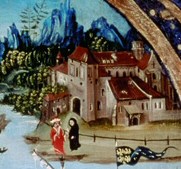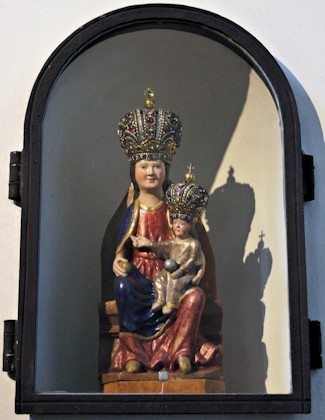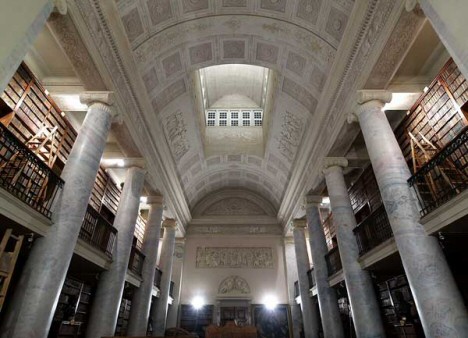The Schottenstift (Scottish Abbey) in Vienna
at the Freyung, today known for its Gymnasium, looks rather sober with its classicistic facades and the winding baroque collegiate church. But it is the oldest monastery in Vienna and was founded in 1155 by Henry II Jasomirgott in the middle ages. The Babenberg Duke Heinrich Jasomirgott moved his seat of government to Vienna and thus founded the rise of Vienna to a cosmopolitan city. He urgently needed a monastery. Only monks were able to read and write and took care of the sick and pilgrims. As Duke of Bavaria he had come to know and appreciate the 'Scots' in Regensburg. So he brought monks from the monastery there to Vienna.

Vienna in the Middle Ages: The Babenberg city wall is marked in red. Now it makes sense why the moat is called "Graben (moat)" and why there is a street called "Tiefer Graben (deep moat)". If you go today through the deep moat to the church Maria am Gestade, you can imagine the former city border. The Babenbergers had their residence at the place called Hof (court). The originally Romanesque Schottenkirche was outside the city walls, as was the Stephanskirche.

That's about how the Scottish monastery could have looked originally. Here is a depiction from the 14th century from the Babenberg family tree. In the foreground are Heinrich Jasomirgott and probably his second wife Theodora of Byzantium.

The Scottish church in the 16th century.
Below: Photos of the Schottenkloster in the Vienna Model in the Museum of the City of Vienna.
After many renovations the Schottenkirche presents itself today as a classicistically renovated baroque church.
Photo: G. Eichinger, Feb. 2007
Memorial of Henry Jasomirgott at the outside of the Schottenkirche (Freyung)
Bernardo Bellotto, called Canaletto, Freyung in Vienna 1758/61
(Original in the Kunsthistorisches Museum Vienna)
If you want to know what it looked like in July 2007, August 2012 or April 2014, click on the small pictures.
Click on the small image from the view October 2011
or on Bellotto's second picture of the Schottenkirche (detail).
A guided tour of the Schottenkloster is highly recommended. It takes place every Saturday in the early afternoon. For details see: http://www.schottenstift.at/

The original Romanesque church was completely rebuilt after the collapse of a tower after lightning in 1638. The neo-Renaissance decoration was done by Heinrich Ferstel in 1889, the ceiling frescos are by Julius Schmid.
Photo: V. Eichinger, August 2012

In the so-called romanesque chapel, which today serves as a day chapel, there is the romanesque statue of Our Lady of Scots (around 1250). It is the oldest representation of the Virgin Mary in Vienna.
The crowns date from a later period.
Foto: G. Eichinger, April 2014

A big surprise is the classicist library (1830) by Joseph Kornhäusel.
The crypt contains the tomb of Henry II Jasomirgott and his second wife Theodora.
At his own request, he was buried with his second wife Theodora in the Scottish Abbey he had founded.
More about the history of Henry II Jasomirgott (* 1107; † 13. January 1177 in Vienna), his first wife Gertrud and the origin of Austria can be found via the link to

QUIZ: "In search of Gertrud"
After the death of her husband, Henry the Proud (Heinrich der Stolze), the 27-year-old widow Gertrud married a second time in 1142, namely Henry II. Jasomirgott (1107-1177).
Henry II was the son of Margrave Leopold III from the Babenberg and Agnes von Waiblingen families, who became famous for their veil legend.
But also Henry II Jasomirgott married twice. Here in the Schottenstift in Vienna founded by him Heinrich found his last resting place together with his second wife Theodora.
His first wife Gertrud of Supplinburg is not buried here.





